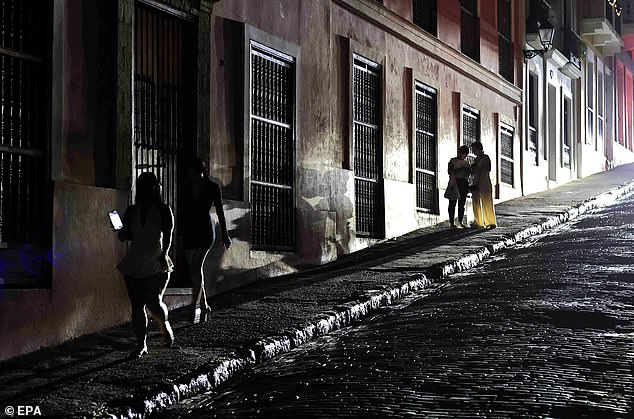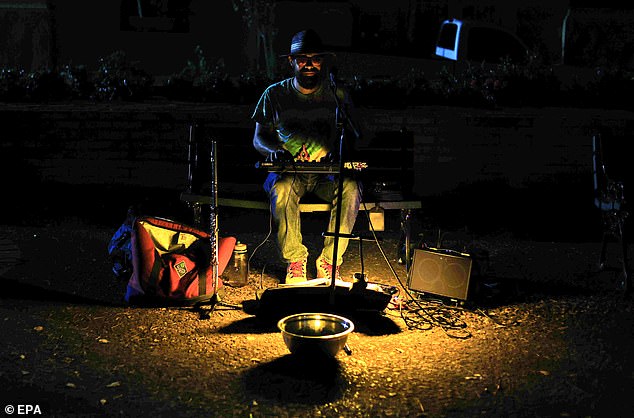More than 1.4 million people in Puerto Rico were plunged into darkness Wednesday after power went out across the entire island.
Local power authorities reported a system failure around 12:40pm —the same time a powerful geomagnetic storm was striking Earth.
A geomagnetic storm is a temporary disruption of Earth’s magnetic field caused by a large burst of solar plasma, typically from a coronal mass ejection on the sun.
Dr Tamitha Skov, an independent space weather physicist, told DailyMail.com that the blackout occurred nearly simultaneously with the intensification of the geomagnetic storm to G4 levels.
A G4 geomagnetic storm—classified as severe on a scale from G1 to G5—can interfere with power grids by producing geomagnetically induced currents (GICs), which may overload transformers and other critical infrastructure.
Officials warned Wednesday that the storm could disrupt the management of electricity flow across the grid, potentially triggering automatic safety systems to shut down parts of the network unintentionally.
Josué Colón, Puerto Rico’s energy chief and former executive director of the Puerto Rico Electric Power Authority, explained that all generators shut down after a failure in the transmission system, even though only one should have entered protective mode.
‘This added stress from GICs likely worsened an already fragile system, especially with power usage near peak levels in the middle of the day,’ Dr. Skov added.

More than 1.4 million people in Puerto Rico were plunged into darkness Wednesday after power went out across the entire island

Local power authorities reported a system failure around 12:40pm —the same time a powerful geomagnetic storm was striking Earth
Luma Energy, the company responsible for overseeing transmission and distribution of power in Puerto Rico, said it restore 90 percent of residents’ power as of Thursday.
Dr Skov said Luma Energy could determine if the solar storm caused the blackout by checking if geomagnetically induced currents (GICs) overloaded the grid with ‘green energy.’
DailyMail.com has contacted Luma for comment.
‘This was a complex event comprised by three separate filament eruptions that occurred April 12 through April 13,’ said Dr Skov.
‘Though these filament structures all got sandwiched together into a single solar storm series, they were magnetically oriented in different ways. Only the second filament structure was oriented in such a way to cause sustained storming at Earth.’
On Wednesday, major power plants across Puerto Rico began shutting down after a failure in a transmission line.
The sudden outage caused refrigerators to stop running, air conditioners to fall silent and traffic lights to go dark.
Hundreds of businesses, including the largest shopping mall in the Caribbean, were forced to close.
Hospitals and Puerto Rico’s main international airport switched to backup generators, while dozens of passengers on a rapid transit train serving San Juan were evacuated by walking along an overpass next to the train tracks.
Authorities are still investigating the exact cause of the blackout. Governor Jenniffer González stated that officials are examining whether several breakers failed to open or possibly exploded.

On Wednesday, major power plants across Puerto Rico began shutting down after a failure in a transmission line. A musician plays in a street during a power outage in San Juan
Another theory is whether overgrown vegetation may have interfered with power lines and caused the transmission failure. Luma Energy is responsible for conducting regular aerial inspections to ensure transmission lines are clear of vegetation.
Pedro Meléndez, an engineer with Luma, said during a Thursday press conference that the specific transmission line involved in the failure had been inspected just last week as part of routine aerial surveillance covering over 2,500 miles of lines across the island. ‘No imminent risk was identified,’ Meléndez said.
The solar storm began on Tuesday, reaching a moderate G2 level overnight.
The following day, the National Oceanic and Atmospheric Administration (NOAA) issued a severe geomagnetic storm alert, cautioning that the event could cause voltage regulation issues and GPS disruptions.
By Wednesday evening, many Americans had already begun experiencing problems with GPS systems.
Users reported that while their systems worked earlier in the day, they became increasingly unreliable as the evening went on.
Meanwhile, the South African National Space Agency (SANSA) confirmed that the solar storm had also affected satellite navigation systems in South Africa.
NOAA extended its space weather warning into Thursday, anticipating that minor geomagnetic activity would persist.
‘Very small, weak power grid fluctuations might occur, especially in high-latitude regions,’ the agency said. ‘Auroras may be visible in areas like Canada and Alaska.’







